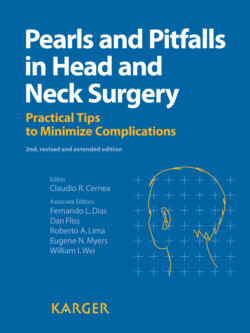Читать книгу Pearls and Pitfalls in Head and Neck Surgery - Группа авторов - Страница 12
На сайте Литреса книга снята с продажи.
ОглавлениеThyroid and Parathyroid Glands
Cernea CR, Dias FL, Fliss D, Lima RA, Myers EN, Wei WI (eds): Pearls and Pitfalls in Head and Neck Surgery. Basel, Karger, 2012, pp 12–13
DOI: 10.1159/000337465
1.6 Surgery for Intrathoracic Goiters
Ashok R. Shahaa James L. Nettervilleb Nadir Ahmadb
aCornell University Medical College, Memorial Sloan-Kettering Cancer Center, New York, N.Y., and bDepartment of Otolaryngology-Head and Neck Surgery, Vanderbilt University Medical Center, Nashville,Tenn., USA
P E A R L S
• Total thyroidectomy (TT) is the optimal management.
• Symptoms related to pressure effects are the main indication for surgery, but potential malignancy is also a concern.
• Cervical approach is usually sufficient to manage large intrathoracic goiters (IG) and sternal split (SS) is rarely indicated.
• Large incision, transection of the strap muscles, and ligation of the inferior thyroid vessels are recommended.
• Preoperative CT scan determines both location and extension of the goiter and its relationship to surrounding structures, especially the recurrent laryngeal nerve (RLN).
• Despite significant tracheal deviation and compression, tracheomalacia is very rare.
P I T F A L L S
• Intraoperative bleeding may be a major concern.
• Risk of RLN injury is much higher though it is usually located in the normal anatomic position.
• Parathyroid glands (PG) may be quite difficult to identify.
• Aggressive, rather than gentle blunt finger dissection is dangerous.
• Approximately 10% of these patients may present with acute airway issues.
Introduction
Intrathoracic or substernal goiter (SG) is defined as a goiter with 50% or more of its mass in the mediastinum (MS) [1]. Its incidence ranges between 2 and 19% of patients undergoing thyroidectomy [1–3]. IG should always be considered in the differential diagnosis of both neck and anterior mediastinal masses.
The origin of IG is commonly an extension of the cervical thyroid gland into the MS, rather than an abnormal growth of a mediastinal-based gland. The cervical source of blood supply to IG attests to its cervical origin in most cases. The majority of IG are benign and can remain asymptomatic for many years. Symptoms typically arise from tracheoesophageal compression.
IGs often extend into the anterosuperior MS, keeping the RLN in its normal configuration. However, IG involving the posterior MS (1-2%) displace the nerve anteriorly. Preoperative imaging with CT scan is important.
Complications inherent to thyroidectomy are more common after IG operations, but still low in experienced hands. Tracheomalacia secondary to long-term compression is surprisingly rare [1]. However, other reports state that it can occur, suggesting to keep a patient intubated for 24-48 h, with controlled extubation [2, 3].
Practical Tips
Nontraumatic intubation with No. 6 or 7 tube is a must. A majority of these patients can be easily intubated since the larynx is generally in its normal position.
The endotracheal tube should be well below the vocal cords, as there is a frequent tendency for the tube to slide back.
The patient should be totally paralyzed during surgery for full relaxation.
A wide skin excision and transection of the strap muscles is recommended for better exposure.
The dissection in the neck should begin with ligation of the middle thyroid vein, ligation of the superior thyroid vessels, and dissection along the lateral border of the thyroid. The area between the anterior border of the trachea and the lateral border of the thyroid should be exposed under vision.
There are several inferior thyroid veins which should be ligated carefully. This procedure can lead to unwarranted bleeding which may be extremely difficult to control. Hemoclips, bipolar electrocautery or Ligasure may assist in this portion of the surgical procedure.
The RLN is better identified after retrieving the thyroid gland from the substernal region. Rarely, a retrograde technique of dissecting the RLN may be necessary, where the nerve is identified near the ligament of Berry and dissected retrograde using a toboggan technique.
PGs are difficult to identify, and if devascularized may occasionally require autotransplantation in the sternomastoid muscle.
SS is seldom necessary, and can involve partial (manubriectomy) or clamshell thoracotomy. A full SS is essential if the thyroid is adherent to the surrounding structures or there is suspicion of malignancy.
Most of the patients can be extubated in the operating room; however, if there is any concern, the tube should remain in place for 24 h.
Suction drain is recommended.
Technical variations, such as retrieving the SG with spoons, or morcellation, have been described, but are not used [2, 3].
Conclusions
SGs form 2-19% of all goiters. The main surgical indication is compression. Approximately 10% of SGs may harbor malignancy. The vast majority can be retrieved through the neck. TT is usually indicated. The surgeon should be familiar with intraoperative manipulation of large SGs and technical variations to retrieve the goiter from the neck. The major complication is hemorrhage in the superior MS.
References
1 Netterville JL, Coleman SC, Smith JC, et al: Management of substernal goiter. Laryngoscope 1998;108:1611–1617.
2 Newman E, Shaha AR: Substernal goiter. J Surg Oncol 1995;60:207–212.
3 Singh B, Lucente FE, Shaha AR: Substernal goiter: a clinical review. Am J Otolaryngol 1994;15:409–416.
4 Shaha AR: Surgery for benign thyroid disease causing tracheoesophageal compression. Otolaryngol Clin North Am 1990;23:391–401.
5 Shaha A, Alfonso A, Jaffe BM: Acute airway distress due to thyroid pathology. Surgery 1987;102:1068–1074.
6 Shaha AR, Burnett C, Alfonso A, Jaffe BM: Goiters and airway problems. Am J Surg 1989;158:378–381.
7 Katlic MR, Wang C, Grillo HC: Substernal goiter. Ann Thorac Surg 1985;39:391–399.
Prof. Ashok R. Shaha
Head and Neck Service
Memorial Sloan-Kettering Cancer Center
Cornell University Medical Center
1275 York Ave.
New York, NY 10021 (USA)
E-Mail shahaa@mskcc.org
